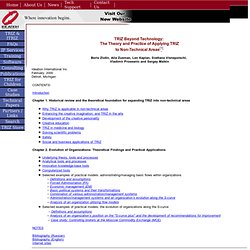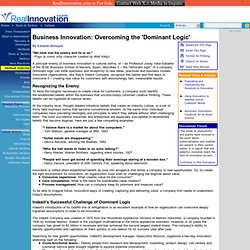Zoom
Trash

11.pdf (application/pdf Object) TRIZ Beyond Technology. TRIZ Beyond Technology: The Theory and Practice of Applying TRIZ to Non-Technical Areas[1] Boris Zlotin, Alla Zusman, Len Kaplan, Svetlana Visnepolschi, Vladimir Proseanic and Sergey Malkin Ideation International Inc.

February, 2000 Detroit, Michigan During the 1970s and 1980s, attempts to apply TRIZ to management and administration problems were entertained on occasion by several TRIZ specialists, primarily for the purpose of enhancing various manufacturing processes. Efforts in this area were limited, however, because in the communist Soviet Union, the privilege of making business decisions belonged to people who had no interest in TRIZ. When we established Ideation International in 1992, we knew that the highest return on our investment (in terms of time and money) would be achieved by applying TRIZ to business and management rather than technology. For over four decades, non-technical applications were not the primary focus of TRIZ.
Chapter 1. Business Innovation: Overcoming the 'Dominant Logic' By Edoardo Monopoli "We have met the enemy and he is us.

"- Pogo (a comic strip character created by Walt Kelly) A principal enemy of business innovation is cultural norms, or – as Professor Josep Valor-Sabatier of the IESE Business School of Navarra, Spain, describes it – the "dominant logic" of a company. Dominant logic can stifle openness and receptivity to new ideas, practices and business models. Recognizing the Enemy To have the insights necessary to create value for customers, a company must identify the established beliefs within the business that unconsciously constrain creative thinking. At the industry level, thought leaders introduce beliefs that create an industry culture, or a set of firmly held business norms that become conventional wisdom. g9730805_陳炫助_全文.pdf (application/pdf Object) Axiomatic_TRIZ_2012.pdf (application/pdf Object) 12.pdf (application/pdf Object) ProblemFormulation.pdf (application/pdf Object) Feb02- Axiomatic Design And TRIZ-Compatibilities and Contradictions.pdf (application/pdf Object)
01.pdf (application/pdf Object) TRIZCon2007-paper-Final +Footer.pdf (application/pdf Object) Inventive Thinking through TRIZ: A Practical Guide - Michael A. Orloff. TRIZ. TRIZ (/ˈtriːz/; Russian: теория решения изобретательских задач, teoriya resheniya izobretatelskikh zadatch) is "a problem-solving, analysis and forecasting tool derived from the study of patterns of invention in the global patent literature".[1] It was developed by the Soviet inventor and science fiction author Genrich Altshuller and his colleagues, beginning in 1946.

In English the name is typically rendered as "the theory of inventive problem solving",[2][3] and occasionally goes by the English acronym TIPS. Following Altshuller's insight, the theory developed on a foundation of extensive research covering hundreds of thousands of inventions across many different fields to produce a theory which defines generalisable patterns in the nature of inventive solutions and the distinguishing characteristics of the problems that these inventions have overcome. There are three primary findings of this research. §History[edit] TRIZ - What Is TRIZ? By Katie Barry, Ellen Domb and Michael S.

Slocum Projects of all kinds frequently reach a point where all the analysis is done, and the next step is unclear. The project team must be creative, to figure out what to do. Eco-Efficient Product Design Using Theory of Inventive Problem Solving (TRIZ) Principles-American Journal of Applied Sciences - Science Publications. Issac L.S.

Sheng and Teoh Kok-Soo DOI : 10.3844/ajassp.2010.852.858 American Journal of Applied Sciences Volume 7, Issue 6 Pages 852-858 Abstract In the pursuit of economic prosperity, the environment is left in the state of decline. Eco-efficiency elements: Eco-efficiency was originally defined by the World Business Council for Sustainable Development (WBCSD) back in 1992 before the Earth Summit in Rio de Janeiro. TRIZ principles: In the 1940s, a Russian inventor by the name of Genrikh Saulovich Altshuller researched for some generic rules that would explain creation of new, inventive, patentable ideas. Cite this Article. Innovation and Management: International Comparisons - Kuniyoshi Urabe, John Child, Tadao Kagono, Nihon Keiei Gakkai. Part_4_proc_3.pdf (application/pdf Object) Innovative product development process by integrating QFD and TRIZ - International Journal of Production Research - Volume 40, Issue 5.
QFD (Quality Function Deployment) has been used to reflect the needs of customers in products, while TRIZ (a Russian acronym for Theory of Inventive Problem Solving) was developed to assist engineers in finding innovative solutions to technical problems in product development processes.

However, no method has been proposed to integrate QFD with TRIZ effectively. This report describes a new method, named the Innovative Product Development Process (IPDP), which systematically integrates QFD with TRIZ and enables the effective and systematic creation of technical innovation for new products. In IPDP, the target products' functions and mechanisms are deployed in parallel into hierarchical structures, and the mechanism that most requires technical innovation is specified from an analysis of customers' needs by calculating a mechanism weight.
Related articles View all related articles.